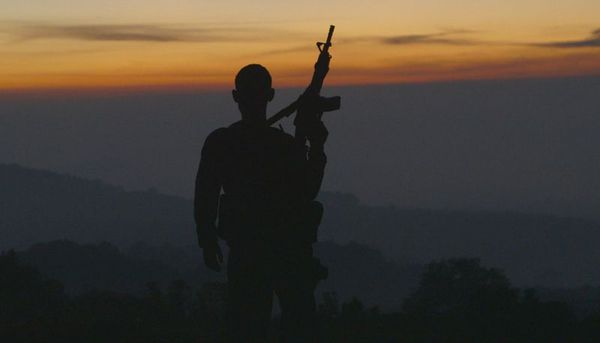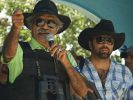Eye For Film >> Movies >> Cartel Land (2015) Film Review
Cartel Land
Reviewed by: Amber Wilkinson

One person's armed vigilante is another person's guardian angel and the border between these two ideas is wafer thin and easily crossed as Matthew Heineman's beautifully shot and probing documentary shows. The director takes a look at both sides of the literal Border between Mexico and the United States to examine the triggers that have led two very different men to put themselves on the frontline of the war on drugs - and questions our attitudes to corruption and non-State intervention in the process.
First, however, Heineman shows us just what is at stake. Acquiring astonishing access to a group of meth cookers, he shoots their large-scale operation at night, plumes of the reacting ingredients so vivid you can almost smell them, curling like cigarette smoke against the darkness as one of those involved gives a stark assessment of their operation. "We know we are doing harm, but what are we going to do?" he says. "We are in poverty. This is not going to end."

Pulling back, Heineman looks at two vigilante set-ups. That of Tim "Nailer" Foley, a veteran and recovering addict himself who since getting clean has become the leader of Arizona Border Recon (listed as an extremist group by civil rights group the Southern Poverty Law Centre). His posse - “The phrase ‘vigilante’ - it’s been given a bad name by the media," he says - initially patrolled the Border with a view to halting illegal emigres but now their focus is on stopping the cartels running drugs to the US.
Foley brands the area the "wild, wild west, there is no law" and his lean, weather-beaten look and gravelly voice give him the air of a maverick in a Sly Stallone movie. Meanwhile, on the other side of the Border, Dr Jose Manuel Mireles has the look of an old-style sheriff in his black hat and sharp duds but nonetheless has a very similar goal in mind - to stop the cartels ruining innocent lives. Where Foley appears to have been driven by ideology to start his patrols (although there is no shying away from the fact that some of his followers are merely cloaking their racism with thin 'justification'), Mireles is spurred on by the very real violence experienced by townsfolk in the state of Michoacan, where the cartels hold sway.
It's an interesting contrast and one that calls into question our notions of taking the law into our own hands. If we feel unsettled by Foley taking up arms, why then does Mireles seem, at least initially, to generate more sympathy with his Autodefensas movement? The reality, of course, is considerably more complex than that and Heineman dives into it with what appears to be little thought for his own safety. Following Mireles as he becomes a local celebrity, Heineman is at the heart of the media storm around but also frequently in the middle of a hail of gunfire as the Autodefensas try to rout drug operators out of the area town by town. Even in dangerous situations, Heineman's camera is unflinching as is his watch over Mireles who, we come to learn, has some weak spots in his principles. As the movement grows, so do the 'man management' issues as the border between the cartel activities and the violent tactics of the Autodefensas begins to blur.
"We don't want our movement to get dirty," says Mireles, but there is a growing sense of inevitability about it, depressingly enhanced by the suggestion that government-run police are little more than authorised cartels in themselves. This idea of cycles is enhanced by Heineman's use of timelapse, which though cropping up quite regularly in documentaries underlines the issue here and is, like all the footage, handsomely captured. Although the US side of the argument is thinner than the Mexican one - there is no reaction to Foley from 'regular' residents included, whereas Heineman does an excellent job of showing the spectrum of opinion on the ground in Michoacan - activities in the US still provide an interesting counterpoint to the fight back down south. All the while, there is the nagging sense of poverty driving the trade, a poverty that even Mireles, with his privileged doctor's lifestyle, doesn't seem to really comprehend.
If there are conclusions to be drawn, Heineman leaves the pen to do so in our hands, while also showing that in terms of the 'war on drugs', the victims are as much the countrywomen and men of the gangs who make them as the US buyers of the end product.
Reviewed on: 04 May 2015


















